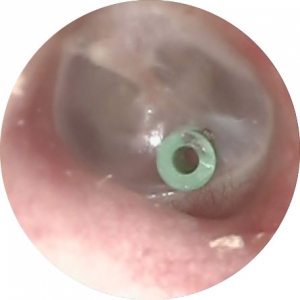Grommets

Also called middle ear ventilation tubes or just tubes.
What are grommets?
Grommets are small tubes that are inserted through the eardrum to allow ventilation of the airspace on the other side of the eardrum. This space is also known as the middle ear. For the ear to work normally this middle ear space needs to contain air at normal atmospheric pressure. There are different designs of grommets, most commonly short to medium stay designs are used but on occasion long stay grommets may be required.
When are they indicated?
- Recurrent middle ear infections
- Persistent fluid in the middle ear
- Occasionally for Eustachian tube dysfunction or recurrent barotrauma
How long do they last?
Short to medium stay grommets last on average 9 to 12 months. Sometimes they may extrude early or may last up to 2 years. On rare occasions they do not come out by themselves and may need to be removed. Long stay grommets are designed to stay in for several years.
The operation in children
This is a simple procedure performed as day surgery. General anaesthesia is administered via a gaseous technique. No breathing tubes or needles are required in most cases. Whilst under the anaesthetic and using a microscope a small incision is placed in the eardrum and the Grommet is positioned through the incision.
The operation in adults
In most cases this can be performed under topical anaesthesia in the consulting room without the need for hospitalisation. No injections are required. Occasionally in narrow or difficult ear canals admission to day surgery with general anaesthesia may be necessary.
After Surgery
Recovery is generally quite rapid and within an hour or so the child is usually comfortable and able to be discharged. However given that they have received an anaesthetic they must be kept home for 24 hours. Thereafter return to normal activities including school is reasonable.
In adults who had the procedure under topical anaesthesia return to normal activities is immediate in most cases.
Pain relief
Pain is not normally a major problem following grommets. One or two doses of paracetamol may be required. It is not unusual for adults to report dullness or a blocked feeling in the ear for a few days.
Water precautions
Different doctors have different policies with regard to keeping ears with grommets in them dry. If a significant amount of water gets through the Grommet into the middle ear there is a risk of infection. If this does occur it is not a major problem in most cases.
That said I think it is advisable to reduce this risk by keeping the ear as dry as possible. Therefore I do recommend using either cotton wool or earplugs for showering and earplugs and an ear wrap for swimming.
Not all children however are overly happy to wear these. I don't believe it is important enough to make your or their life a misery over it, so if they won't wear them it is reasonable to try without.
Flying
Having a functioning grommet actually makes flying easier. Most ear problems with flying are due to an inability to equalise the air pressure in the middle ear. Because the Grommet allows free flow of air between the middle ear and the atmosphere pressure trauma does not occur. In most cases flying should be possible by the next day.
Discharge from the ear
Grommets are ventilating tubes and as such their function is to let air into the middle ear, not to facilitate drainage. If there is a mucoid discharge from the ear this normally indicates infection. It will usually settle fairly readily with antibiotic eardrops. If you notice a discharge please contact my rooms for an appointment or see your General Practitioner.
Postoperative instructions
You will be given instructions for care upon discharge. These are also available to download here. At discharge you will also be given a post-operative appointment and my mobile phone number.
Follow-up
The first follow up appointment will normally be within 2 to 3 weeks of the surgery. Thereafter I will review every four or six months. It is important that this follow-up is maintained, as some people will develop recurrent problems after the tube extrudes and on occasion repeat grommets are required.
In 1 to 2% of cases there may be a hole left in the eardrum after the grommet extrudes. This may need to be repaired so again follow up is important.